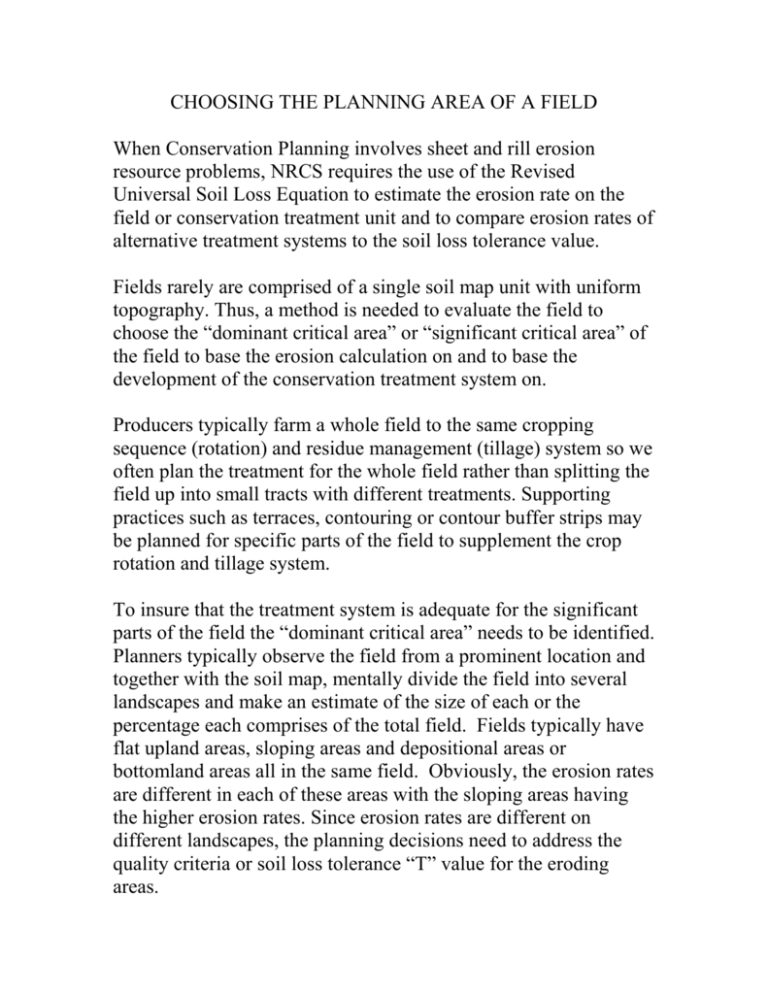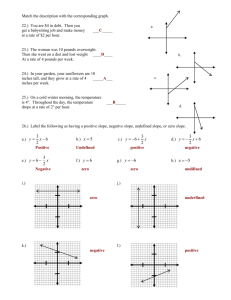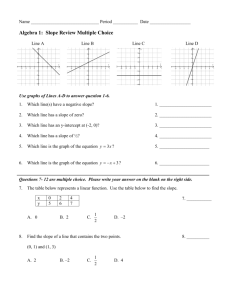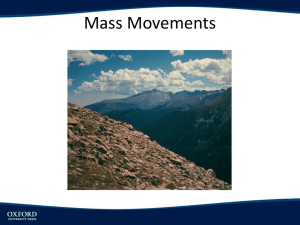Choosing the planning area of a field
advertisement

CHOOSING THE PLANNING AREA OF A FIELD When Conservation Planning involves sheet and rill erosion resource problems, NRCS requires the use of the Revised Universal Soil Loss Equation to estimate the erosion rate on the field or conservation treatment unit and to compare erosion rates of alternative treatment systems to the soil loss tolerance value. Fields rarely are comprised of a single soil map unit with uniform topography. Thus, a method is needed to evaluate the field to choose the “dominant critical area” or “significant critical area” of the field to base the erosion calculation on and to base the development of the conservation treatment system on. Producers typically farm a whole field to the same cropping sequence (rotation) and residue management (tillage) system so we often plan the treatment for the whole field rather than splitting the field up into small tracts with different treatments. Supporting practices such as terraces, contouring or contour buffer strips may be planned for specific parts of the field to supplement the crop rotation and tillage system. To insure that the treatment system is adequate for the significant parts of the field the “dominant critical area” needs to be identified. Planners typically observe the field from a prominent location and together with the soil map, mentally divide the field into several landscapes and make an estimate of the size of each or the percentage each comprises of the total field. Fields typically have flat upland areas, sloping areas and depositional areas or bottomland areas all in the same field. Obviously, the erosion rates are different in each of these areas with the sloping areas having the higher erosion rates. Since erosion rates are different on different landscapes, the planning decisions need to address the quality criteria or soil loss tolerance “T” value for the eroding areas. Some fields may also have a small insignificant area of 10% or less of the field or less than a couple of acres that is much steeper and more erosive. These areas are usually not dominant and it would be impractical to plan the treatment system for this area and apply it to the whole field. This would significantly over treat the field and would be impractical to the producer. Opportunities exist to split out this area and develop it as a wildlife area or recreation area with permanent cover or to apply additional supporting practices to the cropping and tillage practices planned for the critical significant area. Like wise, it is improper to plan the treatment for the largest common landscape in cases where it is the flattest and least erosive. In this case the other sloping areas will be under treated. Additionally, planning to average slope or weighted average slope in the field is improper since it results in areas that are under treated. Determining slope lengths and grades. Using RUSLE2 to determine the erosion rates for the sloping areas of the field involves determining slope lengths and grades. This is best done by an onsite evaluation. Several slopes are typically shot until one’s judgement determines that a common length and grade is representative of the landscape in question. Slope length for conservation planning The accuracy of most topographic maps is not adequate to determine slope grades or lengths in the office. Slope grades and lengths contained in soils databases are not site specific and may vary considerably from specific sites due to the nature and methods used in making soil surveys. Determining slope grade Slope is always measured perpendicular to the contour or directly up and down the slope in the direction that gravity forces the water to run. That water runs downhill is a basic fact of life. Slope grades can be measured using a hand level or clinometer or Abney level. Another person or a range pole or other device is used to establish the “eye height” at a point on the slope and is placed at either the top or bottom of the slope or at the points where major slope breaks occur when dealing with slopes having segments with different grades. When using a hand level a sighting is made from a measured or paced distance such as 50 or 100 feet up or down from the range pole or helper and the difference in elevation recorded and converted into percent slope. When using the clinometer or abney level the cross hair is lined up with the “eye height” on the distant range pole or helper and the grade read directly. Determining slope lengths Slopes for RUSLE are measured perpendicular to the contour line starting at the origin of overland flow near the top of the hillslope and terminate at either significant deposition where the slope flattens significantly or at the point where flow concentrates in a larger channel, ephemeral gully or gully. Slopes 2, 3 and 4 end at concentrated flow, while slope 1 ends and deposition. Slopes are generally shorter on low gradients, longer at moderate gradients and shorter again on steeper gradients. Slope length related to slope gradient 350 slope length 300 250 200 150 100 50 25 23 21 19 17 15 13 11 9 7 5 3 1 0 slope grade This is due to the fact that flow tends to spread out and be more diffuse at low gradients and tends to become more concentrated at steeper gradients. Concentrated flow channels tend to form higher on the slope as gradients increase, thus slope lengths tend to be shorter since they terminate at these concentrated flow channels rather than at depositional areas. RUSLE currently does not estimate gully or ephemeral gully erosion and is confined to sheet and rill erosion. Thus slope lengths are restricted to the erosion processes modeled by the program. A useful training exercise for a group of students is to go to a sloping field with several concentrated flow channels on the slope and lay out a level contour line across the slope. Flags are set every 30 to 50 feet along this line. Observing this line, one will note that it curves up in each of the concentrated flow channels and bows down on the nose or crowns of the slope. Students are taught that water always runs perpendicular to the contour and that slope lengths begin at the origin of overland flow and terminate at concentrated flow or at significant deposition. Students are positioned at various points along the contour line and each student is given two flags and asked to set a flag at the top of the slope and at the point where the slope stops. Some will place flags at the top of the slope and at the depositional area at the base of the sloping landscape where it grades into a bottomland or depositional area. This length will be quite long and represent a fairly small portion of the landscape. Most will place flags at the top and at a point in the concentrated flow channel forming a slope profile running at a 30 to 45 degree angle to the concentrated flow channel. These slopes will represent a majority of the landscape. RUSLE Slopes The planner often measures several slopes on the significant critical area in a similar fashion after mentally observing the contour line and observing the landscape before choosing the one slope that most nearly represents the eroding landscape to be used in planning the field.






